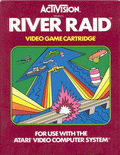
































River Raid

River Raid is a scrolling shooter video game designed and developed by Carol Shaw, and published by Activision in 1982 for the Atari 2600 video game console. Activision later ported the title to the Atari 5200, ColecoVision, and Intellivision game consoles, as well as to the Commodore 64, IBM PCjr, MSX, ZX Spectrum, and Atari 8-bit family home computers. Activision published River Raid II in 1988. This sequel, programmed by David Lubar, has similar gameplay, but with a different landscape and increased difficulty. The Atari 2600 version of River Raid was republished via Microsoft's Game Room service in May 2010; River Raid II followed in June 2010.
Viewing from a top-down perspective, the player flies a fighter jet over the River of No Return in a raid behind enemy lines. The player scores points for shooting enemy tankers (30 pts), helicopters (60 pts), fuel depots (80 pts), jets (100 pts), bridges (500 pts), and (in non-Atari 2600 versions of the game) hot air balloons (60 pts).
The jet refuels when it flies over a fuel depot. A bridge marks the end of a game level. The player's jet crashes if it collides with the riverbank or an enemy craft. In non-Atari 2600 versions of the game, tanks alongside the river also fire at the player's jet. If the player's jet runs out of fuel, it crashes. Assuming fuel can be replenished, and the player evades damage, gameplay is essentially unlimited. Unlike later scrolling shooters, there is little or no enemy fire in River Raid. Also, the player's jet cannot maneuver up and down the screen, only left and right. It can, however, accelerate and decelerate.
For its time, River Raid provided an inordinate amount of non-random, repeating terrain despite constrictive computer memory limits. For the Atari 2600 the game with its program code and graphics had to fit into a 4 KB ROM. The game program does not actually store the sequence of terrain and other objects. Instead, a procedural generation algorithm manifests them by employing a linear-feedback shift register with a hard-coded starting value, also called a pseudorandom number generator. Because of this the algorithm generates the same game world every time the program executes. The enemy crafts' AI relies on another pseudorandom number generator to make the start of the enemy movement less predictable as this pseudorandom number generator's starting value is not reset when a new game starts.
River Raid was the first video game to be banned for minors in West Germany by the Bundesprüfstelle für jugendgefährdende Schriften (Federal Department for Works Harmful to Young Persons, now called the Federal Department for Media Harmful to Young Persons).
How to play:
Click on the joystick icon in the River Raid online emulator to see how to control the River Raid game









































Comments